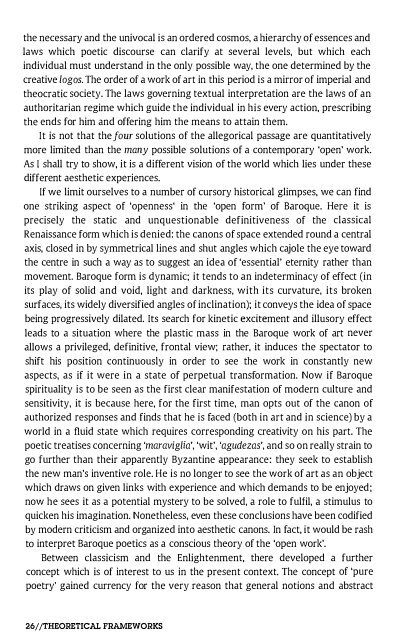Create successful ePaper yourself
Turn your PDF publications into a flip-book with our unique Google optimized e-Paper software.
the necessary and the univocal is an ordered cosmos, a hierarchy of essences and<br />
laws which poetic discourse can clarify at several levels, but which each<br />
individual must understand in the only possible way, the one determined by the<br />
creative logos. The order of a work of art in this period is a mirror of imperial and<br />
theocratic society. The laws governing textual interpretation are the laws of an<br />
authoritarian regime which guide the individual in his every action, prescribing<br />
the ends for him and offering him the means to attain them.<br />
It is not that the four solutions of the allegorical passage are quantitatively<br />
more limited than the many possible solutions of a contemporary 'open' work.<br />
As I shall try to show, it is a different vision of the world which lies under these<br />
different aesthetic experiences.<br />
If we limit ourselves to a number of cursory historical glimpses, we can find<br />
one striking aspect of 'openness' in the 'open form' of Baroque. Here it is<br />
precisely the static and unquestionable definitiveness of the classical<br />
Renaissance form which is denied: the canons of space extended round a central<br />
axis, closed in by symmetrical lines and shut angles which cajole the eye toward<br />
the centre in such a way as to suggest an idea of 'essential' eternity rather than<br />
movement. Baroque form is dynamic: it tends to an indeterminacy of effect (in<br />
its play of solid and void, light and darkness, with its curvature, its broken<br />
surfaces, its widely diversified angles of inclination); it conveys the idea of space<br />
being progressively dilated. Its search for kinetic excitement and illusory effect<br />
leads to a situation where the plastic mass in the Baroque work of art never<br />
allows a privileged, definitive, frontal view; rather, it induces the spectator to<br />
shift his position continuously in order to see the work in constantly new<br />
aspects, as if it were in a state of perpetual transformation. Now if Baroque<br />
spirituality is to be seen as the first clear manifestation of modern culture and<br />
sensitivity, it is because here, for the first time, man opts out of the canon of<br />
authorized responses and finds that he is faced (both in art and in science) by a<br />
world in a fluid state which requires corresponding creativity on his part. The<br />
poetic treatises concerning 'maravigUa', 'wit', 'agudezas', and so on really strain to<br />
go further than their apparently Byzantine appearance: they seek to establish<br />
the new man's inventive role. He is no longer to see the work of art as an object<br />
which draws on given links with experience and which demands to be enjoyed;<br />
now he sees it as a potential mystery to be solved, a role to fulfil, a stimulus to<br />
quicken his imagination. Nonetheless, even these conclusions have been codified<br />
by modern criticism and organized into aesthetic canons. In fact, it would be rash<br />
to interpret Baroque poetics as a conscious theory of the 'open work'.<br />
Between classicism and the Enlightenment, there developed a further<br />
concept which is of interest to us in the present context. The concept of 'pure<br />
poetry' gained currency for the very reason that general notions and abstract<br />
26jjTHEORETICAL FRAMEWORKS








